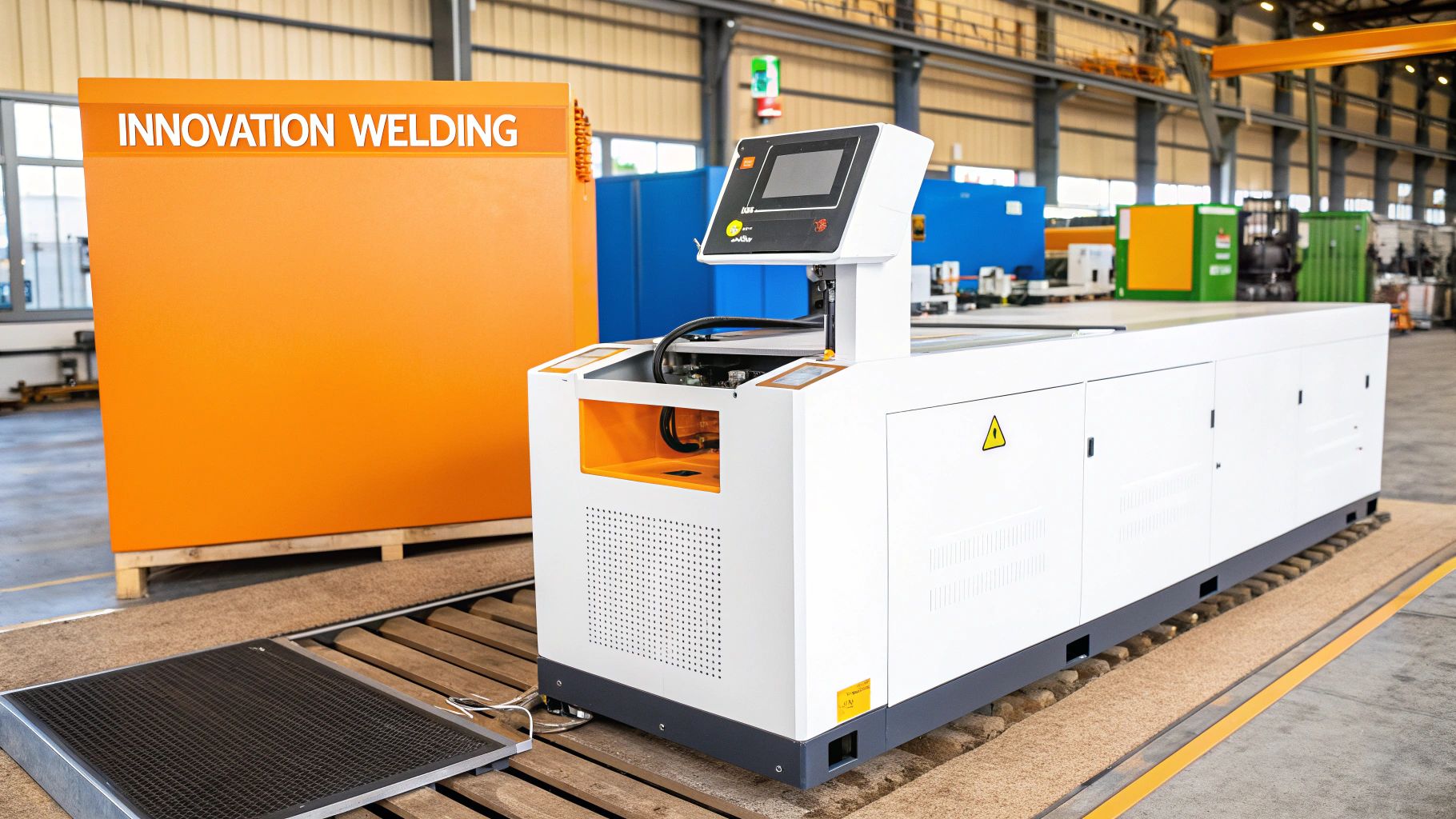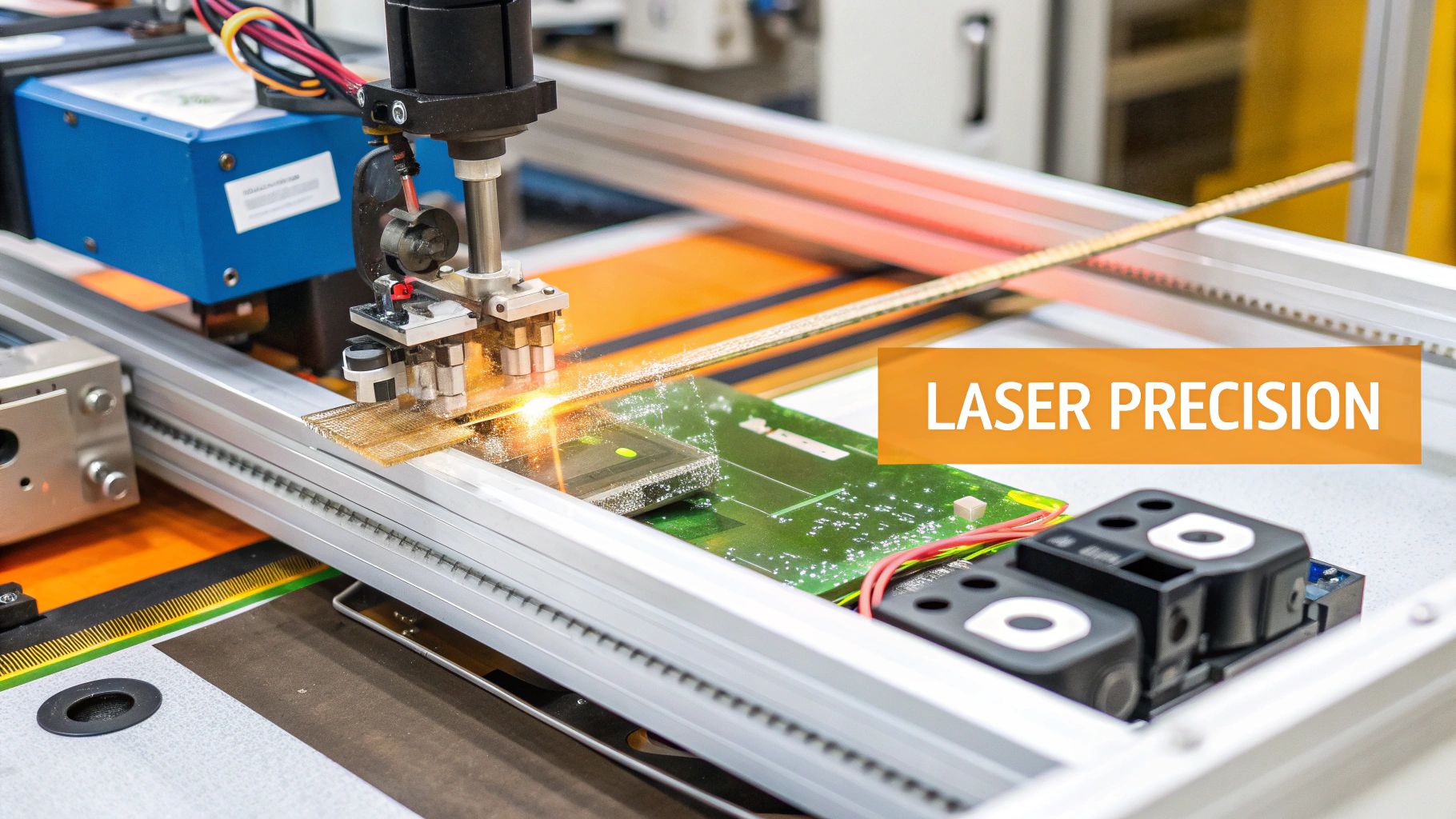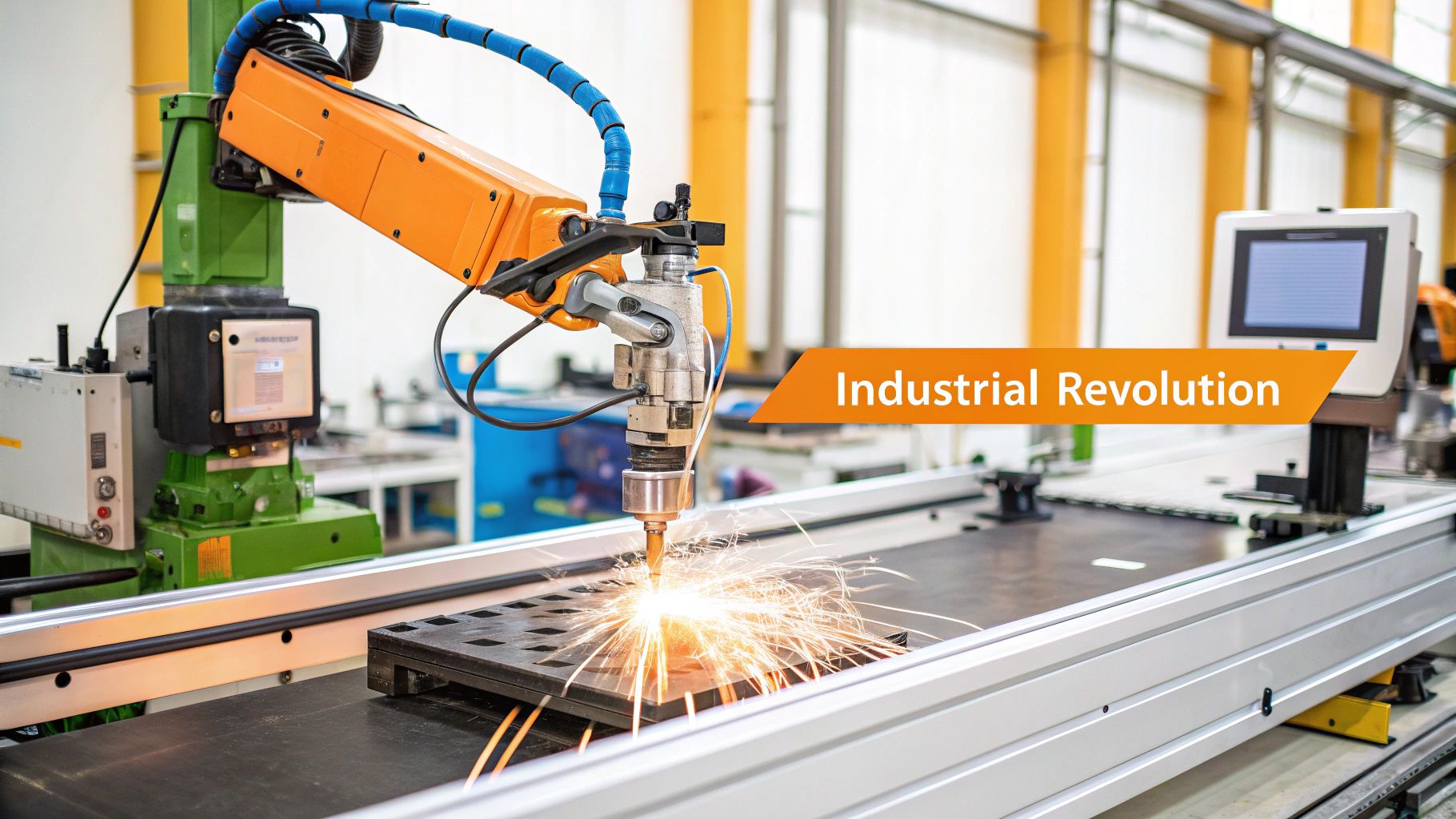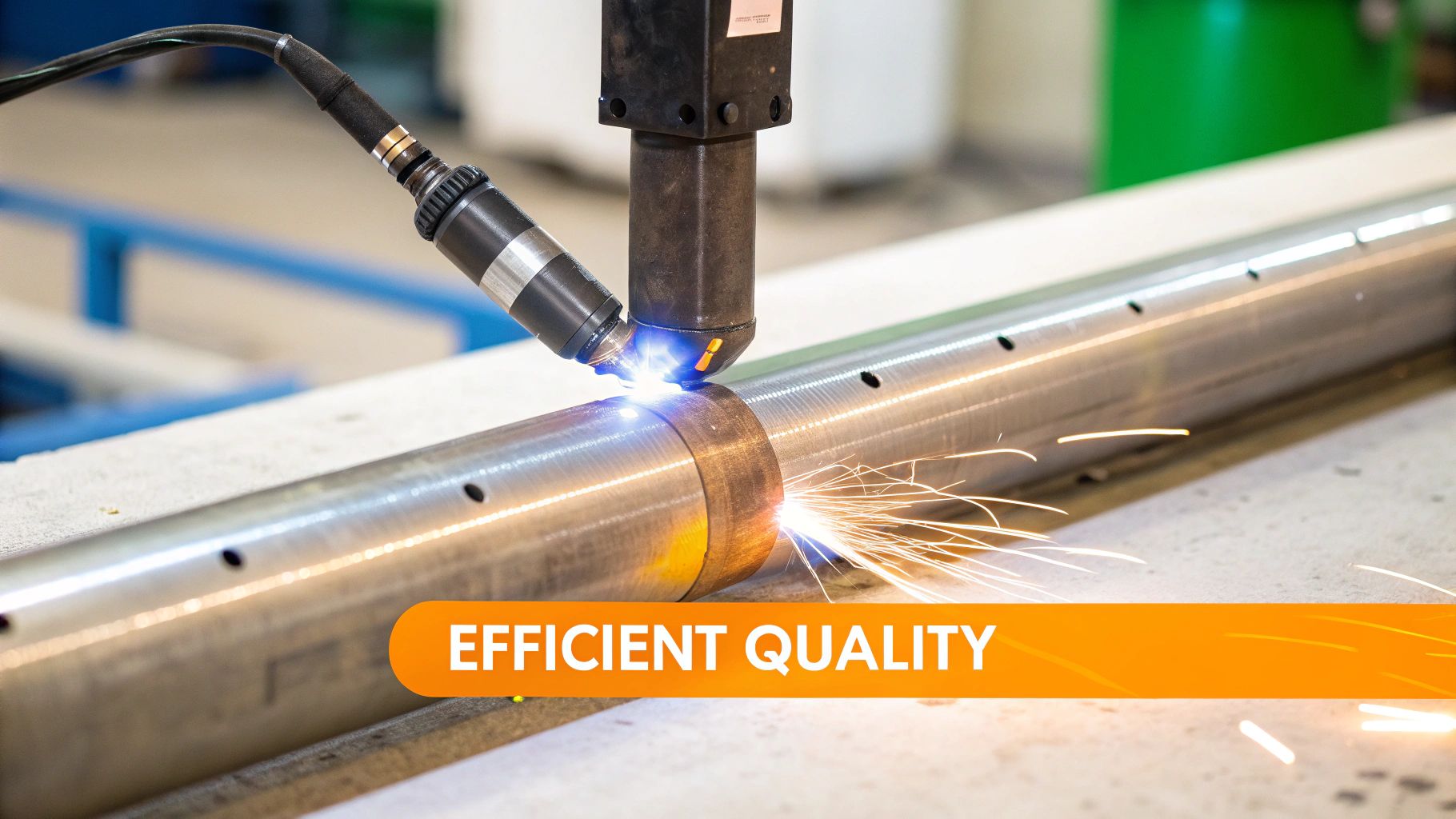The Evolution of Precision: Understanding Fiber Laser Welding

Fiber laser welding machines represent a major advancement in joining technology. They offer manufacturers an exceptional degree of control and accuracy, changing how industries approach precision joining. Unlike traditional methods like MIG or TIG welding, fiber lasers produce a highly concentrated beam of light. This creates intense heat exactly where it's needed.
This focused energy minimizes heat-affected zones, reducing distortion and enhancing the overall weld quality. This precision is especially important when dealing with delicate or intricate parts.
Core Components of a Fiber Laser Welding Machine
Understanding the core components provides insight into the unique capabilities of fiber laser welding machines. The laser source is the heart of the system, generating the high-intensity light beam.
This light is transmitted through a beam delivery system, typically a flexible fiber optic cable, guiding the laser to the workpiece. Finally, advanced controls enable operators to fine-tune parameters like power, speed, and focus. This ensures optimal weld characteristics for a variety of materials and applications. You might be interested in: Our sitemap.
Market Growth and Accessibility
The increasing use of fiber laser welding isn't simply a passing trend; it signifies a fundamental change in manufacturing. The global fiber laser welding machine market, for instance, has seen substantial growth.
In 2024, this market segment was valued at USD 1.2 billion. Projections indicate it will reach USD 1.8 billion by 2034. This impressive expansion is due to the inherent benefits of fiber lasers: long operational lifespan, minimal maintenance requirements, and remarkable stability.
These advantages make them well-suited for industries requiring precise and cost-effective welding. The decreasing cost of fiber laser sources, driven by increased competition, has also made the technology accessible to a broader range of businesses. Find more detailed statistics here: Laser Welding Machine Market. This increased accessibility fuels further growth and adoption of fiber laser welding technology, promoting innovation and efficiency across various sectors. From automotive and aerospace to electronics and medical devices, fiber laser welding is becoming the go-to method for creating high-quality, dependable joins.
Game-Changing Advantages of Fiber Laser Welding Machines

Fiber laser welding machines are quickly changing the face of manufacturing. They offer a unique combination of precision, speed, and efficiency that outperforms traditional welding methods. This translates to better product quality, lower operating expenses, and more design flexibility.
Unmatched Precision and Minimal Heat Distortion
One of the biggest advantages of fiber laser welding is its remarkable precision. These machines produce incredibly fine welds, sometimes as small as 0.01mm. This level of accuracy is crucial for creating complex parts used in electronics, medical devices, and other high-precision fields.
The highly focused laser beam also minimizes the heat-affected zone. This means less distortion in the surrounding material, resulting in cleaner welds and reducing the need for post-weld finishing.
Enhanced Efficiency and Speed
Fiber laser welding machines offer incredible energy efficiency, converting up to 80% of input power into usable laser energy. This contrasts sharply with traditional methods like MIG and TIG welding, which typically only convert around 20%. This difference contributes to lower energy use and operating costs.
Fiber lasers also operate at high speeds, sometimes exceeding 10 meters per minute. This speed, combined with less rework, significantly boosts production output.
Joining Dissimilar Materials and Reducing Scrap
Fiber lasers' focused energy delivery allows for the joining of dissimilar materials, opening up new design possibilities and enabling the creation of innovative products. For instance, fiber lasers can efficiently weld copper to aluminum, a difficult task for conventional welding techniques.
The precision of fiber laser welding also minimizes errors and defects, leading to significantly lower scrap rates. This material savings contributes to overall cost reductions and better resource management.
Lower Operational Costs and Increased ROI
The initial investment for a fiber laser welding machine might be higher than traditional equipment. However, the long-term operational costs are often significantly lower. The lower energy consumption, minimal maintenance, and longer lifespan translate to a higher return on investment (ROI).
Increased productivity and reduced scrap further contribute to substantial cost savings over the machine's lifetime. These financial benefits make fiber laser welding machines a smart investment for manufacturers aiming to improve profitability and competitiveness.
To further illustrate the advantages of fiber laser welding, let's look at a comparison table:
To illustrate the key differences between fiber laser welding and other common welding methods, the following table provides a comparison across several performance metrics.
Fiber Laser Welding vs. Traditional Welding Methods Comparison of key performance metrics between fiber laser welding and conventional welding technologies
| Performance Metric | Fiber Laser Welding | TIG Welding | MIG Welding | Resistance Welding |
|---|---|---|---|---|
| Precision | Very High (0.01mm) | High | Moderate | Low |
| Speed | Very High (10+ m/min) | Low | Moderate | High |
| Heat Affected Zone | Very Small | Small | Moderate | Large |
| Energy Efficiency | Very High (up to 80%) | Low (around 20%) | Low (around 20%) | Moderate |
| Material Compatibility | Wide, including dissimilar materials | Wide | Moderate | Primarily metals |
| Operating Cost | Low | Moderate | Moderate | High |
This table highlights the key advantages of fiber laser welding, particularly in precision, speed, and efficiency. While other methods have their strengths, fiber lasers offer a compelling combination of benefits for many applications. Specifically, the significantly smaller heat-affected zone and higher energy efficiency contribute to reduced operating costs and increased ROI over time.
Industry Transformations Through Fiber Laser Technology

Fiber laser welding machines are not simply enhancing manufacturing; they are reshaping industries. This exploration delves into their significant impact across diverse sectors. A prime example is the automotive industry, where these machines are changing vehicle construction.
Automotive Advancements
From electric vehicle batteries to lightweight frames, fiber lasers are essential. They join dissimilar materials, like aluminum and high-strength steel, key for lighter, more fuel-efficient cars. This allows complex designs previously impossible with traditional methods, leading to innovative vehicle architectures.
The speed and precision of fiber laser welding boost production, reducing time and costs. This increased productivity is vital for meeting the demand for electric and hybrid vehicles. Manufacturers can deliver high-quality vehicles faster and more affordably. But the automotive industry isn't the only one benefiting.
Electronics and Beyond
In electronics, fiber laser welding machines are crucial for miniaturized components in smartphones and medical devices. Creating tiny, precise welds is essential for these intricate parts, improving reliability and performance. Explore the Laser Industry Blog Posts for more on laser technology.
The aerospace industry also benefits greatly. Fiber laser welding enables the creation of strong, lightweight turbine components and fuel systems for extreme conditions. The precision ensures these parts meet stringent aerospace requirements. Benefits extend further, impacting medical implants and even luxury watches. The fiber lasers segment holds approximately 43% of the market share as of 2024. This is largely due to the flexible fiber optic cables used to deliver the laser beam, enabling precise welding in complex shapes. This is particularly useful in the automotive and aerospace sectors, where precision is paramount. The rising adoption of fiber lasers in these sectors, combined with their cost-effectiveness and energy efficiency, makes them a top choice. Learn more about laser welding machine market trends.
The following table summarizes industry-specific applications, showcasing the versatility of fiber laser welding.
Industry-Specific Applications of Fiber Laser Welding
| Industry | Key Applications | Materials Commonly Welded | Special Requirements |
|---|---|---|---|
| Automotive | Battery welding, body structures, powertrain components | Aluminum, high-strength steel, stainless steel | High speed, automation, deep penetration |
| Electronics | Micro-welding of circuit boards, sensor packaging, battery connections | Copper, gold, aluminum, nickel | High precision, minimal heat-affected zone |
| Aerospace | Turbine components, fuel systems, fuselage sections | Titanium, aluminum alloys, nickel alloys | High strength, lightweight welds, resistance to extreme temperatures |
| Medical | Implants, surgical instruments, medical device assembly | Titanium, stainless steel, biocompatible alloys | Sterility, precision, biocompatibility |
| Luxury Goods | Watch components, jewelry | Gold, platinum, stainless steel | Aesthetics, precision, minimal material distortion |
This table highlights how various industries utilize fiber laser welding for specific manufacturing needs, demonstrating the technology's adaptability and importance in modern manufacturing.
Adaptability Across Diverse Applications
From heavy machinery to delicate watchmaking, fiber laser welding adapts to various scales and materials. Whether joining thick steel or welding tiny medical implants, these machines deliver exceptional results. This versatility makes them invaluable across industries, solidifying their role in modern manufacturing. They are enhancing quality, boosting efficiency, and driving innovation across the board.
Finding Your Perfect Fiber Laser Welding Match

Choosing the right fiber laser welding machine is a big decision for any manufacturer. It's not just about buying a piece of equipment; it's about finding the perfect tool to boost your production. This means thinking about several factors beyond the initial price.
Power and Beam Quality: The Foundation of Precision
The first step is figuring out the power you need. The ideal power level depends on the materials you're welding and how deep you need the weld to be. Welding thicker stainless steel, for example, needs more power than welding thin aluminum sheets.
Beam quality is just as important. This refers to how focused and intense the laser beam is. It directly affects the weld's precision and how consistent it is. A high-quality beam creates narrower, cleaner welds with less heat, which reduces distortion. This is particularly important for intricate parts and welding different types of materials together.
Automation and Integration: Streamlining Your Workflow
Another key factor is how well the machine works with automation. Many fiber laser welding machines integrate smoothly with robotic arms, CNC systems, and Industry 4.0 networks. This integration allows for automated welding, increasing speed, consistency, and efficiency.
Automation frees up skilled welders for more complicated jobs and makes high-volume production runs easier. Automation is essential for businesses that want to scale up. However, you need to assess your current workflow and what you'll need in the future to choose the right level of automation.
Workspace, Cooling, and Operator Interface: Practical Considerations
Practical considerations are also important for day-to-day use. The machine's footprint and needed workspace must fit within your facility. Effective cooling systems are essential to prevent overheating and maintain top performance, especially during long production runs.
The operator interface matters too. A user-friendly control panel with clear displays and intuitive controls makes operation easier and reduces training time for new operators. This boosts productivity and minimizes mistakes. These factors, though sometimes overlooked, significantly affect efficiency and the overall user experience.
Total Cost of Ownership: Looking Beyond the Purchase Price
Finally, consider the total cost of ownership. The initial price is important, but ongoing costs like energy use, maintenance, consumables, and the machine's lifespan also affect the overall cost.
A fiber laser welding machine with a higher upfront cost might be cheaper to run in the long term because it uses less energy and requires less maintenance. Think about long-term value, not just the initial price. Carefully considering these factors ensures you select a fiber laser welding machine that gives you the best return on your investment and meets your specific needs. By focusing on these key areas, you can choose a machine that enhances your production and gives you a competitive advantage.
Global Innovation: The Future of Fiber Laser Welding
Fiber laser welding machines are constantly evolving. Driven by market demands and technological advancements, these machines are continually pushing the boundaries of what's possible in welding.
Intelligent Manufacturing Through Real-Time Monitoring and AI
One exciting development is the integration of real-time monitoring. Sensors track vital parameters such as laser power, beam quality, and weld temperature. This instant feedback allows for on-the-fly adjustments, optimizing the welding process and ensuring consistent, high-quality results.
AI-assisted parameter optimization is also gaining traction. AI algorithms analyze real-time data and automatically adjust welding parameters, boosting speed and accuracy while minimizing errors. This is especially helpful for complex welds that demand precise control. This shift towards intelligent manufacturing transforms fiber laser welding machines into smart, interconnected components within larger production systems.
Compact Designs and Enhanced Energy Efficiency
Manufacturers are prioritizing smaller, more energy-efficient machines. The need to conserve valuable floor space in manufacturing facilities drives the demand for compact designs. Moreover, increased energy efficiency is both an environmental and a financial necessity.
New fiber laser welding machines minimize energy consumption while maximizing output, resulting in lower operating costs. This focus on efficiency translates into significant long-term savings for manufacturers, enabling them to achieve excellent welding results with a smaller environmental footprint and reduced energy bills.
Beam Shaping and Multi-Material Processing: Expanding Possibilities
Beam shaping technology is another major advancement. By manipulating the laser beam's shape and intensity, manufacturers can achieve highly specialized welds tailored to specific needs. This level of precision provides greater control over weld characteristics, such as penetration depth and width.
Advancements in multi-material processing are also opening up new possibilities. Fiber laser welding machines are increasingly capable of joining dissimilar materials with enhanced precision and reliability, leading to the creation of innovative products with unique material combinations. The rising demand for electric vehicle batteries, for instance, relies heavily on the ability to efficiently join lightweight materials like aluminum and copper.
Increased Accessibility for Smaller Manufacturers
Fiber laser welding is becoming increasingly accessible to smaller manufacturers. New business models, like leasing and shared access programs, are lowering the initial investment barrier. This increased accessibility allows smaller businesses to leverage the advantages of fiber laser welding and compete more effectively.
This democratization of advanced manufacturing technologies is driving innovation across various industries. The Asia-Pacific region, in particular, is poised for substantial growth in the laser welding machine market, including fiber laser technology. This market is projected to grow by approximately 37% between 2024 and 2029, making it the fastest-growing globally. China, with its thriving electronics manufacturing sector and numerous manufacturing plants, will be a key driver of this growth. Factors contributing to the region's market strength include cost-effective production, a skilled workforce, and government support for technological advancements. The increasing focus on electric vehicle battery production in countries like China and India further fuels the demand for precise and efficient laser welding machines, especially those utilizing fiber laser technology. Learn more: Laser Welding Machines Market. These trends indicate a future where fiber laser welding machines are not only more powerful and versatile, but also more crucial to the success of manufacturers of all sizes. Continued advancements in beam control and multi-material processing promise even greater potential for this already vital technology.
Maximizing Your Fiber Laser Welding Investment
A fiber laser welding machine is a considerable investment. To ensure it performs optimally year after year, proactive maintenance and adherence to best practices are essential. This section explores how leading manufacturers get the most from their fiber laser welding equipment.
Preserving Beam Quality: The Heart of Precision
The beam quality of your fiber laser welding machine is critical for achieving precise and consistent welds. Maintaining this quality depends heavily on the proper care of the optical components. Regularly cleaning the lenses and mirrors prevents the accumulation of contaminants. These contaminants can scatter or absorb the laser beam, diminishing its power and impacting weld quality.
Protecting the fiber optic cable from damage is also crucial. Excessive bending or improper handling can compromise the cable's ability to transmit the laser beam effectively. This can result in inconsistent welds or even equipment malfunction.
Preventative Maintenance: Minimizing Downtime and Maximizing Lifespan
Like any complex piece of machinery, your fiber laser welding machine requires regular preventative maintenance. Establishing a consistent maintenance schedule can significantly reduce downtime and prolong the equipment's operational life.
This schedule should include:
- Regular inspections of all components
- Cleaning and replacing filters
- Calibration of sensors and controls
- Lubrication of moving parts
This proactive approach addresses potential issues before they escalate into major problems requiring expensive repairs or replacements. For further information, check out this resource: How to master laser maintenance.
Troubleshooting Common Challenges: Proactive Solutions
Even with diligent maintenance, occasional issues can occur. Understanding common problems and their solutions empowers operators to address them quickly and efficiently.
Two common challenges include:
- Power fluctuations: These can stem from problems with the power supply, the laser source, or the beam delivery system. Checking connections, calibrating the laser source, and inspecting the fiber optic cable are key troubleshooting steps.
- Focal point drift: This happens when the laser's focal point deviates from its intended position, resulting in inconsistent welds. Recalibrating the focusing lens and ensuring correct workpiece positioning can rectify this issue.
Creating a troubleshooting guide tailored to your specific fiber laser welding machine model, coupled with readily available spare parts, can minimize downtime and maintain production efficiency.
Operator Training: Empowering Your Team for Success
Properly trained operators are vital for maximizing both safety and productivity. A comprehensive training program should encompass:
- Safe operating procedures
- Correct machine setup and configuration
- Understanding welding parameters and their impact
- Basic troubleshooting techniques
Equipping operators with the knowledge and skills to use and maintain the equipment effectively ensures consistent weld quality, minimizes errors, and boosts overall productivity.
Documentation and Quality Control: Ensuring Consistency
Maintaining detailed records of welding parameters, maintenance performed, and any troubleshooting undertaken is essential for long-term success. This documentation offers valuable insights into the machine's performance and helps pinpoint potential areas for improvement.
Implementing quality control procedures, such as routine weld inspections and testing, guarantees consistent results across production runs. This consistency builds customer confidence and enhances your reputation for reliability. By integrating these practices, you can extract maximum value from your fiber laser welding machine and achieve lasting success.
Ready to explore the potential of fiber laser welding? Discover how Laser Insights China can enhance your manufacturing capabilities.

